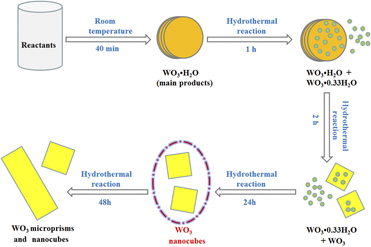Crossref Citations
This article has been cited by the following publications. This list is generated based on data provided by
Crossref.
Zhang, Xin
Zhang, Xianwen
and
Wang, Chongmin
2019.
Building advanced materials via particle aggregation and molecular self-assembly.
Journal of Materials Research,
Vol. 34,
Issue. 17,
p.
2911.
Zhou, Rong-Hui
Wei, Zhi-He
Li, Yan-Yang
Li, Zhong-Jun
and
Yao, Hong-Chang
2019.
Construction of visible light–responsive Z-scheme CdS/BiOI photocatalyst with enhanced photocatalytic CO2 reduction activity.
Journal of Materials Research,
Vol. 34,
Issue. 23,
p.
3907.
Lin, Chunling
Gao, Yifeng
Zhang, Jiaoxia
Xue, Dan
Fang, Hua
Tian, Jiayong
Zhou, Chunli
Zhang, Chanjuan
Li, Yuqing
and
Li, Honggang
2020.
GO/TiO2 composites as a highly active photocatalyst for the degradation of methyl orange.
Journal of Materials Research,
Vol. 35,
Issue. 10,
p.
1307.
Park, Jongyoon
and
Tabata, Hitoshi
2021.
Gas Sensor Array Using a Hybrid Structure Based on Zeolite and Oxide Semiconductors for Multiple Bio-Gas Detection.
ACS Omega,
Vol. 6,
Issue. 33,
p.
21284.
Bashir, A. K. H.
Morad, R.
Nwanya, A. C.
Akbari, M.
Sackey, J.
Kaviyarasu, K.
Madiba, I. G.
Ezema, F. I.
and
Maaza, M.
2021.
Synthesis, characterization and ab initio study of WO3 nanocubes with peculiar electrochemical properties.
Journal of Nanoparticle Research,
Vol. 23,
Issue. 1,
Nguyen, Cong Tu
Pham, Ngoc Linh
Nguyen, Thi Thuy
Do, Duc Tho
and
Luu, T. Lan Anh
2021.
Effect of reaction time on the phase transformation and photocatalytic activity under solar irradiation of tungsten oxide nanocuboids prepared via facile hydrothermal method.
Phase Transitions,
Vol. 94,
Issue. 9,
p.
651.
Bushkova, T. M.
Egorova, A. A.
Khoroshilov, A. V.
Ivanova, O. S.
Yapryntsev, A. D.
Baranchikov, A. E.
and
Ivanov, V. K.
2021.
Selective Synthesis of γ-WO3 and β-WO3⋅H2O by the Hydrothermal Treatment of Peroxotungstic Acid.
Russian Journal of Inorganic Chemistry,
Vol. 66,
Issue. 4,
p.
496.
Mushtaq, Khizar
Chou, Pui May
Lai, Chin Wei
Chun, K.S.
Leng, C.H.
Myan, F.W.Y.
King, P.S.
and
Zaman, N.
2021.
Review on the Synthesis Methods of Nano-Tungsten Oxide Dihydrate Colloid.
MATEC Web of Conferences,
Vol. 335,
Issue. ,
p.
03008.
Ghosh, Utpal
and
Pal, Anjali
2022.
Insight into the multiple roles of nitrogen doped carbon quantum dots in an ultrathin 2D-0D-2D all-solid-state Z scheme heterostructure and its performance in tetracycline degradation under LED illumination.
Chemical Engineering Journal,
Vol. 431,
Issue. ,
p.
133914.
Mohan, Visakh V.
Anjana, P.M.
and
Rakhi, R.B.
2022.
One pot synthesis of tungsten oxide nanomaterial and application in the field of flexible symmetric supercapacitor energy storage device.
Materials Today: Proceedings,
Vol. 62,
Issue. ,
p.
848.
Palharim, Priscila Hasse
Caira, Maria Clara D.’Amaro
de Araújo Gusmão, Carolina
Ramos, Bruno
dos Santos, Gabriel Trindade
Rodrigues Jr., Orlando
and
Teixeira, Antonio Carlos Silva Costa
2022.
Effect of temperature and time on the hydrothermal synthesis of WO3-AgCl photocatalysts regarding photocatalytic activity.
Chemical Engineering Research and Design,
Vol. 188,
Issue. ,
p.
935.
Filippova, A. D.
Rumyantsev, A. A.
Baranchikov, A. E.
Kolesnik, I. V.
Ivanova, O. S.
Efimov, N. N.
Khoroshilov, A. V.
and
Ivanov, V. K.
2022.
Hydrothermal Synthesis of γ-WO3 and h-WO3 Powders in the Presence of Citric Acid and Their Photoprotective Properties.
Russian Journal of Inorganic Chemistry,
Vol. 67,
Issue. 6,
p.
780.
Khan, Nisar
Gul, Tamanna
Khan, Idrees
Alabbad, Eman A.
Ali, Shahid
Saeed, Khalid
and
Khan, Ibrahim
2022.
Scavenging of Organic Pollutant and Fuel Generation through Cost-Effective and Abundantly Accessible Rust: A Theoretical Support with DFT Simulations.
Materials,
Vol. 16,
Issue. 1,
p.
142.
Xu, Kaixuan
He, Hongbing
Liu, Shouda
Zhao, Xiangbo
and
Gao, Xiaoming
2022.
High-Performance Photocatalytic Degradation of Organic Pollutant with N-C3n4/Bioclxi1-X S-Type Heterojunction: Self-Induced Internal Electric Field and Stretching Spatial Charge Separation.
SSRN Electronic Journal ,
Mahnicka-Goremikina, Ludmila
Svinka, Ruta
Svinka, Visvaldis
Goremikins, Vadims
Ilic, Svetlana
Grase, Liga
Juhnevica, Inna
Rundans, Maris
Eiduks, Toms Valdemars
and
Pludons, Arturs
2023.
Porous Mullite Ceramic Modification with Nano-WO3.
Materials,
Vol. 16,
Issue. 13,
p.
4631.
Lovisa, L. X.
dos Santos, D. F.
Santiago, A. A. G.
Teodoro, M. D.
Bomio, M. R. D.
and
Motta, F. V.
2023.
Synthesis of Pr3+-doped WO3 particles: correlation between photoluminescent and photocatalytic properties.
RSC Advances,
Vol. 13,
Issue. 37,
p.
25738.
Yoo, Seung-Je
Kim, Dohyun
and
Baek, Seong-Ho
2023.
Controlled Growth of WO3 Photoanode under Various pH Conditions for Efficient Photoelectrochemical Performance.
Nanomaterials,
Vol. 14,
Issue. 1,
p.
8.
Jeong, Eunhoo
Jung, Seokho
and
Shin, Hyun-Sang
2023.
Fluorine-functionalized reduced graphene oxide-TiO2 nanocomposites: A new application approach for efficient photocatalytic disinfection and algicidal effect.
Environmental Pollution,
Vol. 319,
Issue. ,
p.
120974.
Ngqalakwezi, Athule
Mapukata, Sivuyisiwe
Raphulu, Mpfunzeni
and
Mampane, Lizzie
2023.
Innovations in Materials Chemistry, Physics, and Engineering Research.
p.
246.
Madeleine, Tristan
D’Alessandro, Giampaolo
and
Kaczmarek, Malgosia
2023.
Spectral properties of intermediate to high refractive index nanocubes.
Optics Express,
Vol. 31,
Issue. 7,
p.
11395.
